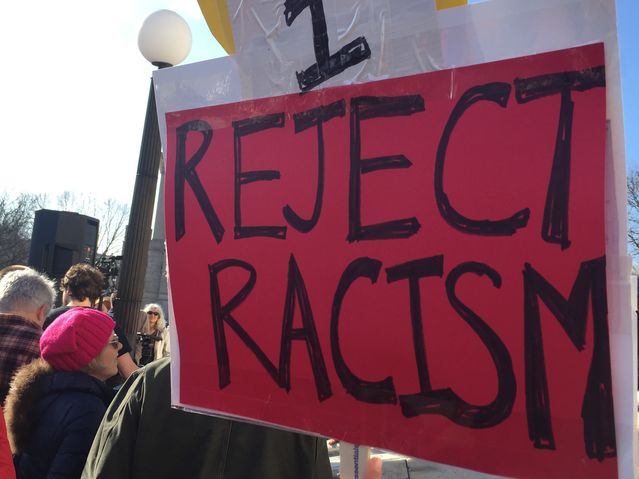Bias
Banning Muslims Is Illegal and Racist
Understanding the Psychology of Racism
Posted January 29, 2017

On Friday, President Trump signed an executive order — lasting at least 90 days — to ban immigrants from entering the U.S. from the seven predominantly Muslim countries of Iran, Iraq, Syria, Yemen, Sudan, Libya and Somalia. It is vital that we understand the cultural psychology implicit in this action. This executive order has psychological implications for a significant marginalized community and thus deserves to be analyzed carefully. The order seemed dismissive of history’s lessons as it was callously issued on Holocaust Remembrance Day. This order is not just illegal, but is also discriminatory, as it excludes a group of people from entering the U.S. specifically because of their national origin and religious beliefs. The move to ban Muslim immigrants is illegal based on the 1965 law Congress enacted forbidding the exclusion of immigrants based on national origin. An excerpt of the executive order attempts to justify as follows: “In order to protect Americans, the United States must ensure that those admitted to this country do not bear hostile attitudes toward it and its founding principles. The United States cannot, and should not, admit those who do not support the Constitution, or those who would place violent ideologies over American law.“ Given that it was issued solely for populations who reside in Muslim countries, there is an unfounded assumption that Muslims from these countries have “violent ideologies.” Such a powerful pronouncement will have a chilling effect on the larger American Muslim community that lives in the United States. It puts Muslims in America and Muslims around the globe on notice and places their religion and identities under a cloud of suspicion.
This executive order harkens back to a time in American history when its constitutional principles of justice for all people were regularly compromised through its history. Today all Americans have a chance to ask themselves whether banning Muslims from specific nations and suspending the refugee program for the vulnerable and displaced people of Syria accurately reflects our professed values of equality, liberty, and democracy. What will this mean for a marginalized group whose members have been under immense stress for over a decade, to be assaulted with new laws aimed at undermining their religious beliefs, nationality, and cultural identities? We have been through dark periods of American immigration history and the results were tragic for many groups and nationalities, yet recent decades have shown America benefits from inclusivity. We need remind ourselves not to repeat the mistakes of the past.
The Dark Days of Exclusionary Acts
The 1882 Chinese Exclusion Act was passed as a response to the perception that Chinese immigrants could not assimilate into U.S. society. The 1907 ‘gentleman’s agreement’ first limited Japanese immigration, then in 1917 Asian Indian immigrants were restricted, followed in 1924 by the Oriental Exclusion Act which suspended labor immigration from mainland Asia, and in 1934 the Tydings-McDuffie Act restricted Filipino immigration to the U.S. Following forty years of discrimination, citizenship through naturalization was denied to all Asians from 1924 to 1943. The main aim of sponsoring these Exclusion Acts was to make sure that the flow of non-European immigration was contained, and these immigrants were allowed ‘in’ only to meet the demands of the fluctuating labor markets in the U.S. (Bhatia, 2007, Mohanty, 1999).
What we know from history is that U.S. immigration, naturalization and citizenship laws were historically based on racist ideologies that played a crucial role in shaping and defining immigrants’ experiences in their workplaces, neighborhoods, schools, places of worship and the broader community. Such stereotyping, racializing and othering was directly connected to the the state-sponsored immigration laws of the U.S. When new immigrants – whether Caribbean, Chilean, Chinese, Indian, Mexican, or Vietnamese – enter the United States, they are introduced to the stories, legacies and the immigration heritage of their respective ethnic group (Bhatia, 2007). Just imagine the impact this executive order will have on young American Muslim youth who have grown up in the U.S. and are now facing intense and often unfair scrutiny of their religion. Today’s second- or third-generation American-Iranians or American-Somalian families, who identify with both their American and their Iranian or Somalian heritages, are essentially being told by the new head of their own government that their parents’ homeland, their legacy, religion, and traditions are under suspicion and are synonymous with terrorism.
The Psychological and Community Impacts of Racial and Social Exclusion
The processes of racial exclusion are structural, systemic, cultural and personal. Its consequences are always lived through the fabric of the community, the individual body and the psychological landscape. In the past, the exclusionary laws of the United States government influenced the day-to-day life of immigrant workers and their families. The harsh effects of these exclusionary acts severely impacted immigrant family configurations (in some cases women and children could not migrate), and in the end set up firm boundaries: outsiders vs. insiders, First World vs. Third World immigrants, natives vs. foreigners, Americans vs. non-Americans and Whites vs. non-Whites. Such outsider-insider relationships were filtered through the lens of racial dominance and socioeconomic hierarchy. These pernicious distinctions were consistently maintained across the U.S.: many migrant communities faced racist taunts, social exclusion and stigmatization as they began settling in urban cities and suburbs. It is important to remember this dark and tragic part of American history, to understand the present context in which Trump’s executive order can embolden others to channel their anger and hate into prejudice against Muslim communities.
The executive order is an example of structural racism that has been a long time in the making. It goes back to September 11, 2001, when the War on Terror opened up a chapter of legitimizing hate against Muslims. Immediately after the events of 9/11 there was a violent backlash in the United States against Muslims and those who were thought to be Muslims. More specifically, the post-9/11 period created a new category of identity in the U.S. by which Arabs, Muslims, and Middle Eastern men were perceived as disloyal and non-patriotic citizens, or as individuals who might be part of terrorist networks. Muslims were guilty until proven innocent.
Researchers Fine and Sirin (2007, p.4) remind us that on on September 11, 2001, “across lines of class, community, religiosity, documented and undocumented status, gender, and politics, Muslim-American youth and their families were abruptly evicted from the moral community of psychological citizenship in the USA ... In an instant ‘they’ could no longer be trusted. They had to be watched, detained, and sometimes deported.” These scholars asked over 200 American Muslim boys and girls and young men and women to “draw a map of your Self.” These maps revealed the psychological space that these youth inhabited as their identities and subjectivities were shaped by global conflicts, negative media representation of Arab and Muslims, and the divisive racist rhetoric in media at large. Fine and Sirin (2007, p.5) wrote:
Quite a few of the maps represented images of conflict, tension, and fear. A young man drew a face split in half, with the words American and Muslim framing the Janus-like face; two tears dripping from the side labeled American and the words ‘tears of racism’ scrawled at the bottom. At the same time, many others drew hybrid images blending the flags of home country and the USA;rivers fed by Muslim and ‘American’ waters; outlines of themselves in hijab with headphones; basketballs and Koran and other portraits of creative and innovative subjectivities at the hyphen.
These maps illustrated the ways in which political events, cultural constructions of Muslims, Islamophobia combined with personal anxieties, fears and fantasies about their homeland and hostland shaped their identity formation. Consider today how young American Muslims might interpret this executive order banning Muslims from seven nations, one of which is their parents’ homeland. What kinds of doubts, anxieties, fears, internalized racism, or conflict might this order create in the developing selves of young American Muslims?
Today American Muslims are under attack once again. Trump’s executive order has created the structural opportunity for a second racist backlash against Muslim communities. Meanwhile Muslim-Americans who have seen their Mosques vandalized or burned and their community subjected to police surveillance will be vulnerable to experiencing deeper waves of cultural and racial alienation. What we are witnessing is the psychology of racism being institutionalized with the full imprint of the law. The GOP and the American people cannot remain silent; they need to resist this order on all fronts. Faith communities, human rights groups, and citizens from all backgrounds need to do everything they can to prevent the racial and moral exclusion of the Muslim community in America. In 2015, a photograph of Aylan Kurdi, the 3-year-old Syrian refugee whose lifeless body was found on a Turkish beach, catalyzed global outrage about the condition of migrants and refugees fleeing domestic and international conflicts. His still face and body pressed against the beautiful sand and waves of the beach became emblematic of the tragedy of the 11 million Syrians who are displaced by the prolonged civil war. The U.S. government should make sure that all children and families who are fleeing zones of war and conflict do not suffer the harm and risk that was experienced by Aylan Kurdi and his family. We need to break the structures that produce racism, hate and social exclusion by welcoming refugee families that are in crisis and by reversing the immigration ban that is imposed on the seven Muslim nations.
Bhatia, S. (2007). American karma: Race, culture, and identity in the Indian diaspora. New York: New York University Press.
Fine, M., & Sirin, K. (2007). Theorizing hyphenated selves: Researching youth development in and across contentious political contexts. Social and personality psychology compass (1), 16-38.
Mohanty, C. T. (1991). Cartographies of struggle: Third world women and the politics of feminism. In C. T. Mohanty, A. Russo, & L. Torres (Eds.), Third world women and the politics of feminism (pp. 2-47). Bloomington, IN: Indiana University Press.




